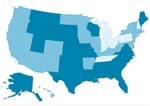Health
Measles outbreak in Indiana linked to failure to immunize
■ Among the lessons learned from a recent flare-up of this vaccine-preventable disease is the importance of ensuring that health care workers are also fully protected.
By Susan J. Landers — Posted Aug. 28, 2006
- WITH THIS STORY:
- » A plane ride away
- » External links
- » Related content
Washington -- Fear among public health officials that a declining rate of immunization among children could lead to an outbreak of a previously controlled disease became an unfortunate reality last year when the largest outbreak of measles to hit the United States in more than a decade swept through an Indiana community.
Thirty-four people, including one hospital worker, were infected by a strain of measles imported from Romania. The resulting outbreak occurred because several families who indicated they had concerns about the vaccines' safety declined to have their home-schooled children immunized, concluded public health workers who helped contain the disease.
About 500 people attended an Indiana gathering with a young woman who had recently returned from a church-sponsored trip to a Romanian orphanage. She had become infected with measles during that trip.
Of the 50 or so people who were at the event and also lacked evidence of immunity to the disease, 16 came down with it. Over the next six weeks, the toll rose to 34, including a 34-year-old hospital employee who was hospitalized. All recovered.
The outbreak provided a case study in the spread of vaccine-preventable infectious diseases. Among the lessons learned: "Relatively small numbers of unvaccinated individuals can produce outbreaks in the United States when vaccination recommendations are not followed for children, foreign travelers and health care workers," concluded Amy A. Parker, MPH, an epidemic intelligence officer with the Centers for Disease Control and Prevention.
Parker was the lead author of a study written about the outbreak and published in the Aug. 3 New England Journal of Medicine.
"I think the message is that we have a good vaccination recommendation but we should enforce it," said study author Gustavo H. Dayan, MD, acting leader for the CDC's measles, mumps and rubella team. If the 17-year-old who traveled to Romania had been vaccinated, there would have been no outbreak, he said.
Every state requires two doses of measles vaccine before children enter school, but only West Virginia has a similar requirement for home-schooled children.
Containment methods
Fortunately, high levels of immunization in the surrounding community prevented the Indiana outbreak from becoming an epidemic, noted the researchers. Cooperation by the church that sponsored the Romanian visit and to which many of those infected belong, as well as by family members who followed quarantine recommendations, were credited with helping to contain the outbreak.
Although the church had no policy against vaccination, the families that refused to be inoculated said they were concerned about adverse events, particularly a link -- which has been studied and discounted -- between the measles, mumps and rubella vaccine and autism.
The vaccine's effectiveness is estimated to be 95%, and there were two cases of vaccine failure among those who contracted the measles, researchers noted. One was the hospital worker who had received a shot at 12 months of age but no second dose as recommended by the CDC. The other was a fully vaccinated student who attended the church gathering.
The fact that the health care worker was vulnerable points up another lesson, said Charlene Graves, MD, pediatrician and medical director for the immunization program at the Indiana State Dept. of Health. The documentation of immunization status is extremely important for those working in hospitals or physicians' offices, she noted, and Indiana has plans to improve its efforts to ensure that this is the case.
Although her state provides some general guidance advising that health care workers should have immunity from infectious diseases, the advice doesn't go beyond that, at least not yet, said Dr. Graves.
"We have just started to think about doing a more intensive survey of hospitals in our state as to what their employee health practices are regarding immunization status," she said.
Indiana does not have any plans to require the vaccination of home-schooled children. The numbers are small, Dr. Graves said -- an estimated 1% of the school-age population. Indiana, like many other states, allows medical and religious waivers of vaccine requirements, although not philosophical waivers, which are granted by some states. The number of state waivers granted cover fewer than 0.4% of school-age children, she said.
Expenses tallied in treating the hospital worker were $113,647. Costs of containing the outbreak in the community were estimated at $167,685 or nearly $5,000 per patient
Costs included paying for personnel, telephone calls and miles driven to track down contacts of infected people as well as for 550 laboratory specimens tested.












